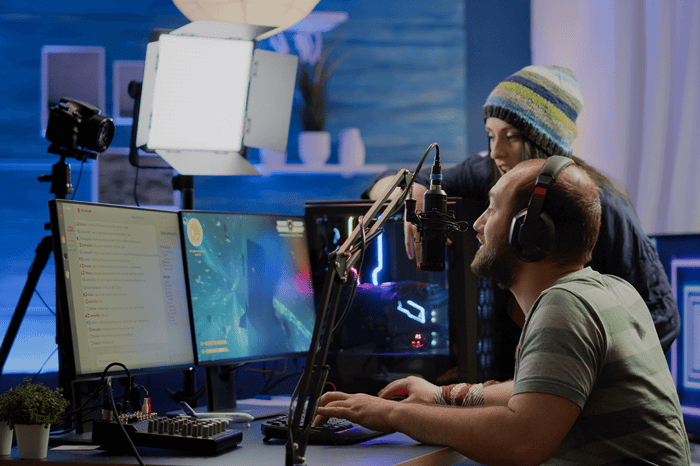
The ol’ duality of blue collar labor jobs vs white collar office jobs stuck around for a long time.
Enter the year 2020 and with it- The 'Rona
A lot of those workers were scooped up by their collars and tossed out into the cold of the new so-called “gig economy” unexpectedly. (Radical paradigm shift, my ass—2020 sucked.) Those of us who were lucky (or unlucky) enough to stay at our jobs ended up at makeshift work-from-home stations in miserable Zoom-based approximations of the old physical workplace.
You know, to keep the time-wasting banter and office politics going during the hard times.
But, This Lifestyle Started Long Before That
The movement away from the blue/white collar paradigm started well before COVID—it really picked up steam in the mid-2010s. Freelancers, gig workers, solopreneurs, and digital nomads became crucial, but experimental parts of the economy. The majority had one thing in common: they could work without having to be at a particular location—or dress a certain way.
But starting your own business is more than that; to be a no collar worker means to avert direct management and organization rules—to take control of your own work life… at least as much as possible.
The cliché but extremely desirable dream: to “be your own boss.”
All in exchange for a lot of risks, a lot more responsibilities, and usually, a hell of a lot more work. Working 120 hours a week for yourself to avoid working 40 for someone else, and all that.
But it’s like they say: if you’re not willing to take risks, you will have to settle for the ordinary. And who wants ordinary?
Even though being a “no collar” worker is essentially becoming mainstream at this point, it’s a hugely different path from the well-trod white/blue collar career tracks. Success rarely comes easy, to say the least.
Then again, your personal idea of “success” might not necessarily be easier for you to achieve when you’re in the office attached to a desk or trying to meet impossible production quotas at a factory either.
What do you get in return for all the risks you take when you venture into the freelance/entrepreneur world?
Well, there’s no 9 to 5—unless you want there to be. For some people, maintaining those classic business hours works, for others it doesn’t. Or if you’ve always been most productive between, say, 2AM and 6AM, you can work then. It depends what you’re doing exactly, of course. But just like we found out after COVID hit, a lot of the work we do can really be done at any hour—as long as it gets done in time.

When you’re no collar you also have the freedom to work from anywhere—a cozy corner of your residence, coffee shops, hotel rooms, lounging at the beach, you get the idea. It’s up to you. All you have to do is make sure the work gets done for your clients, and keep the sand out of your laptop fan vents somehow.
Unless your chosen profession requires you to visit clients at their locations, it’s your choice where you plop down your laptop and get to work—no one else’s.
When you’re working for yourself at your own business, you also get to choose what work you do. Not just in the beginning when you’re deciding what you want to do—but when new work shows up in front of you, it’s an offer—not an executive order coming down from the bosses upstairs. At least, if you’re keeping your client boundaries properly maintained, that is.
When you’re just getting started, it’s tempting (that’s an understatement) to grasp for ANY and ALL work opportunities that hover into your field of vision. Yeah, it might be necessary to do this for a while to get some income coming into your business, but ultimately the way things work is you choose who you work with, and what work you accept from them.
A lot of freelancers and entrepreneurs out there end up in this situation: “I’m my own boss... the only ones who can tell me what to do are my clients, who are all my bosses too.”
No collar workers don’t have to work with anyone who approaches them (especially overly demanding, whiny, or generally annoying people). White collar and blue collar workers don’t have that luxury.

And on the other end, while you can (and will) lose clients for a variety of reasons, no one can fire you from your position. That means you can continue to post inappropriate things on social media without worrying about someone emailing our manager!
The no collar worker is paid for the work that they put in and the value and results they deliver.
The more you work, the more you make. The better results you create, the more you make. All the work you put in benefits you and your clients—no more picking up the slack for your lazy coworkers who spend all day at work without doing any.
The way things are now, you don’t have to be a bland tech savant from Silicon Valley who gets a billion dollars from an angel investor to start up your business (wouldn’t that last part be sweet, though?)
You can use your own personal resources to start a no collar life and carve out a nice niche for yourself while doing some great, fulfilling work for people you actually like.
As the entrepreneur and founder of Hootsuite Ryan Holmes says, “You don’t have to convince investors about the merits of your idea. You just have to convince yourself.”





